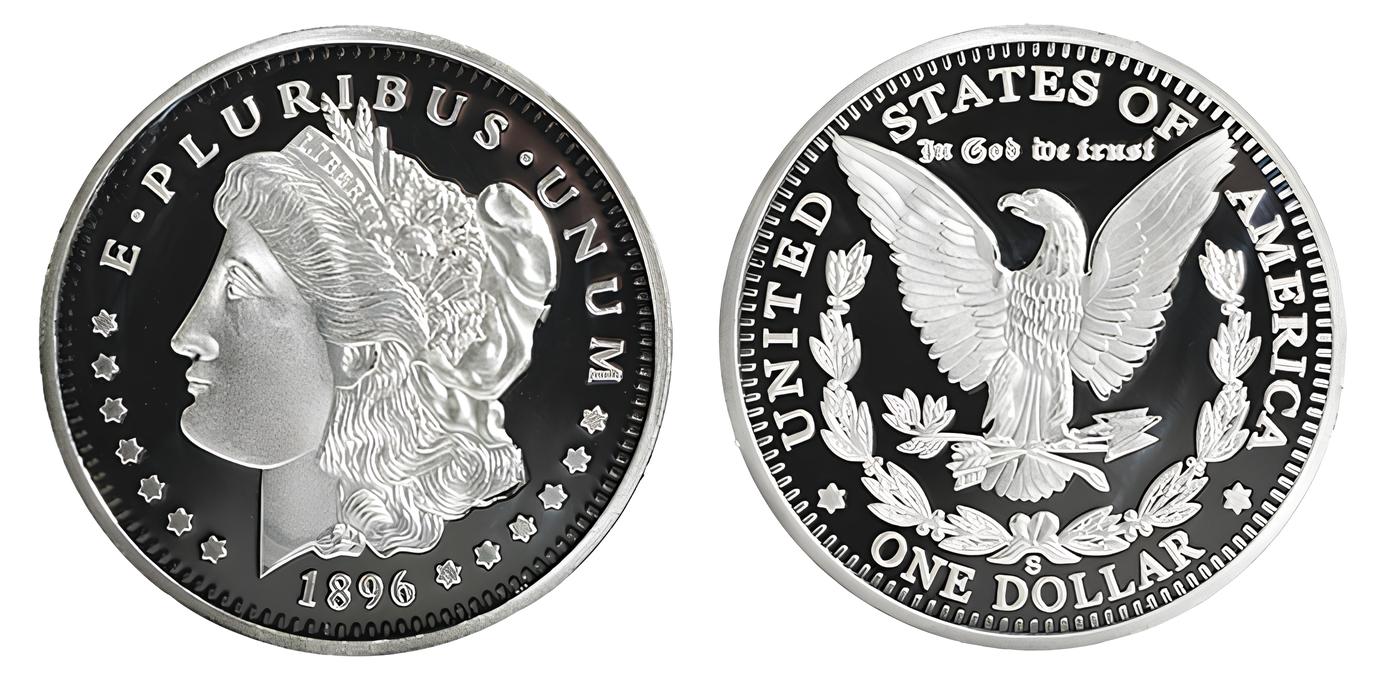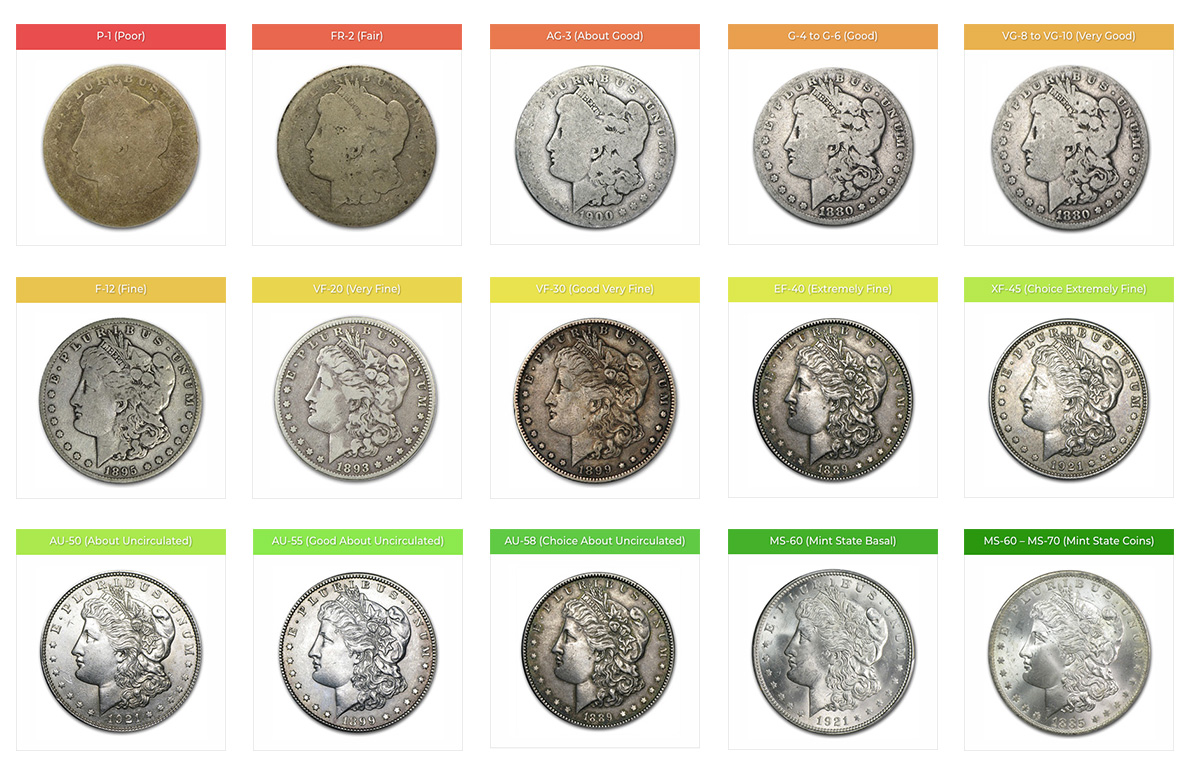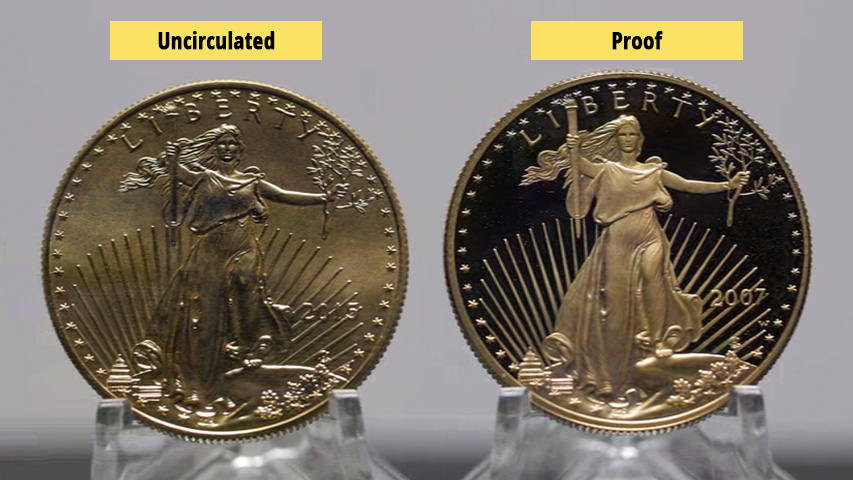
Do you know what “brilliant uncirculated” means? As the name implies, the description of a gold or silver coin as brilliant uncirculated means that it has never been circulated as currency and still retains its original luster. You may also hear BU coins referred to as “mint state” or simply, “uncirculated.”
None of these terms exactly refer to one particular coin grade. Instead, they may describe coins authenticated to be in pristine condition and of the highest grade.
See exactly which coin grades and conditions can earn the description of brilliant uncirculated.
What Are Brilliant Uncirculated Coins?
Have you ever seen a rare coin with a label that marked it as brilliant uncirculated, or BU? In contrast to worn, old coins or even typical pocket change, you could probably see that this coin looked very shiny and free from damage. You also found the details and lettering sharp and distinct. Very likely, a plastic slab or other container protected the coin.
Typical use damages the coins that people use as currency. Getting rubbed against other coins in a wallet, tumbling through vending machines, or even being handled eventually causes wear and scratches. Exposure to the elements can dull the luster.
Mostly, the condition of currency doesn’t impact its value, so nobody bothers to grade them. On the other hand, even slight differences in the condition of rare coins can affect their value greatly.
What Coin Grades Are Brilliant Uncirculated?

Today, the Professional Coin Grading Service (PCGS) uses the Sheldon Scale as the basis for its own coin grading system. Dr. William Sheldon, a famous coin collector and expert, developed this scale in 1948.
PCGS assigns formal grades to coins that reflect their assessment of quality.[1] Coins receive grades from one to 70.[2] One indicates a coin so worn or damaged it’s barely recognizable. A coin with no visible, post-production imperfections at 5X magnification could earn a 70.
This list explains brilliant uncirculated grades:
- A grade from 60 to 70 indicates a brilliant uncirculated coin.
- “MS” before the grade indicates mint state, or a business-strike coin that has never been circulated. These coins may be manufactured exactly the same as currency but never circulated.
- If you see “PR” before the grade, you will know you have found a proof coin. By itself, proof doesn’t indicate a particular grade.[3] Instead, it indicates higher quality manufacturing methods used to produce coins that were always intended as collectibles and not currency.
Why Is the Condition of Rare Coins Important?
Within reason, the condition of a circulating coin won’t affect its value much. It’s simply worth its face value because it’s used as currency. Shiny or dull, the ordinary dime in your pocket is probably worth ten cents.
In contrast, a rare coin’s condition can have a big impact upon its numismatic value. For instance, collectors might pay as much as $1.2 million for a rare 1927 D St. Gaudens Double Eagle in mint state, or uncirculated condition. If you had the same Double Eagle in average condition, you may only be offered less than one-quarter of that sum.[4]
The Basics of Coin Grading
PCGS introduced the idea of putting coins inside a transparent holder after grading. You might hear this holder referred to as a “slab.” The plastic slab allows people to view the coin while it keeps it safe from exposure to most hazards or tampering.

Everything you need to know to get started in Precious Metals
Learn how precious metals can strengthen your portfolio, protect your assets and leverage inflation.
Request the Free GuideThese are general qualities graders use to judge coins:
- Flaws: Negative flaws might include scratches, chips, or dents upon the coin. Even some uncirculated coins may have bag marks, or small scratches caused by other coins.
- Luster: Typically coins that still retain their original luster will grade higher than those that have grown dull or tarnished.
- Wear: When people handle coins or leave them exposed, the minute details may show signs of wear.
The differences between grades are subtle and might not even be visible without magnification. One coin may have an excellent luster but have small scratches, and another coin may look somewhat dull but be free of scratches.
Collectors tend to rely upon professional graders. These professionals have the right resources and years of training and experience to spot small differences and make judgments.
Proof Coins Vs. Uncirculated Coins

The U.S. Mint produces proof grade coins by polishing the dies and blanks and then striking the blanks with the dies multiple times. This produces a stunning result. They’re relatively rare because the U.S. Mint limits this costly production process.
Typically, you will find proof coins packaged with an official Certificate of Authenticity from the Mint. Since they’re more expensive and rarer than ordinary currency, people tend to buy, store, and sell them as collectables. Thus, you will find plenty of uncirculated proof coins.
The U.S Mint also produces some uncirculated coins with a Certificate of Authenticity.[5] Of course, you might buy a roll of regular coins that haven’t technically been circulated from your bank, but they’re not the same. Uncirculated coins with a Certificate of Authenticity have benefited from a manufacturing process that’s an upgrade over typical circulating currency coins but not as rigorous as proof coins. Plus, you won’t get a certificate with a bank roll.
You can still get these coins graded by a professional, but unless they’re rare, you probably cannot justify the cost. You might have read a story about lucky people who found six- or even seven-figure coins in pocket change. Still, this happens very rarely and typically, the lucky individual knew what to look for.
Brilliant Uncirculated vs. Bullion Coins
A numismatic coin’s value depends upon rarity, demand, condition, and history. For numismatic value, brilliant uncirculated coins are likely to enjoy a much greater value than coins in poor or average condition.
Of course, you should also consider the rarity and demand for the coin. Sometimes, a very rare coin that many collectors covet could fetch more in average condition than a more common coin could in mint state. On the other hand, some coins may not have gotten noticed by collectors yet, so collectors may hope to obtain them when they’re relatively inexpensive and hold them for the promise of future gains.
In contrast, investors buy bullion coins more for their precious metals content than for any collectable value (Learn more about Bullion. Read: “What is Bullion?”). Beyond the chance that circulation may have worn down any significant portion of the metal content, bullion investors don’t tend to consider condition so important that they would need to establish 70 different condition grades. While the scarcity and demand for gold or silver may matter, investors don’t think much about those factors when it comes to the coin’s design or history.
Is Mint State the Same as Brilliant Uncirculated?
Brilliant uncirculated typically refers to coins with a grade of 60 or above. So, it’s possible to use mint state or proof state as synonyms for brilliant uncirculated. A collector or coin dealer may also use gem brilliant uncirculated to describe coins with a grade of at least 65.
Discover More about Investing in Precious Metals
Now you know what a brilliant uncirculated coin is, as well as a bit about mint state, proof, and bullion coins.
If you’d like to learn more, check out our free guide, “Introduction to Investing in Precious Metals.”
